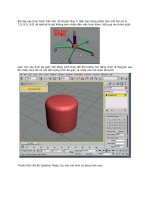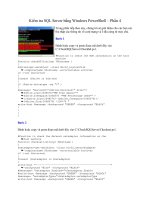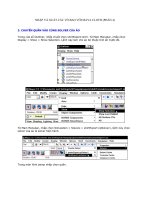Core Banking with Microsoft Technology phần 4 pptx
Bạn đang xem bản rút gọn của tài liệu. Xem và tải ngay bản đầy đủ của tài liệu tại đây (143.28 KB, 6 trang )
29 Core Banking with Microsoft Technology 29
Human workflow: Windows SharePoint Services and Microsoft Office SharePoint
Server.
System workflow: Microsoft BizTalk® Server, which provides integration services as well.
It can also be used with Windows SharePoint Services and other products to create
combined human and system workflows.
Business rules engine: The BizTalk Server BRE. Microsoft also provides a rules engine
with Windows Workflow Foundation, part of Microsoft .NET Framework 3.0.
Business activity monitoring: The BizTalk Server BAM, together with technologies such
as Microsoft Office Excel and Office PerformancePoint™ Server business intelligence
software for displaying BAM information.
Process description tools: Microsoft Office Visio® drawing and diagramming software.
In other words, Microsoft encompasses within BPM both human workflow and system
workflow—sometimes also referred to as process flow—and has been implementing a strategy
to unify both types of workflow into a single workflow engine: the one which is now part of the
.NET development environment.
A good example of what this means can be seen for document-centric workflows, which can be
defined by end-users through a specialized user interface that is part of workflow development
in Microsoft Office SharePoint Designer (Figure 13).
30 Core Banking with Microsoft Technology 30
Figure 13. Workflow Designer user interface in Microsoft Office SharePoint Designer
In order to apply these technologies in the context of migration to a next-generation core
banking platform, a number of prerequisites need to be addressed first. Often the first step
consists of making legacy system transactions available as ―services‖ by removing their user
interface and making them accessible using a standard protocol. However, the ultimate
objective of an SOA-based approach is likely to go beyond this and start to introduce a
number of reusable ―services‖ that can be invoked without unwanted side-effects or
unnecessary duplication.
An example might be a typical branch banking transaction that involves the following standard
―services‖:
Available balance check
Credit limit check
Calculation of fees
Production of a customer document
Generation of accounting entries
31 Core Banking with Microsoft Technology 31
Let‘s assume there is an existing transaction for moving funds from one account to another
that uses these services. Assuming that each of these services is available as a reusable and
flexible ―enterprise service,‖ then it would be relatively easy to introduce a new transaction—
perhaps a funds transfer between two accounts in different currencies.
This may require the addition of two services not previously used but originating in and
available from the bank‘s treasury department.
Currency conversion
Currency position update
This does mean that such enterprise services need be designed much in the same way that
software vendors design packages that must be capable of being implemented in many
different organizations in different geographies and under different regulatory regimes. In this
case, it means that the services must be aware of the need to accommodate different
currencies.
In fact, should a new requirement arise that is not currently addressed by an existing service
(for example the pricing service cannot cope with different currencies) and assuming a service-
oriented architecture has been put in place, it then becomes possible to consider whether it is
more cost-effective to enhance the existing in-house service or to buy a specialized one from a
software vendor instead.
It is also clear how—once such a set of services is available—the associated process can be
enhanced significantly by means of workflow and business rules.
Let‘s say, for example, that a regulatory requirement is introduced that mandates that funds
transfers into a foreign currency are subject to a maximum amount, beyond which they
become subject to the need for review and approval by a manager in the bank. Given that the
amount may change over time, it makes sense to implement this compliance rule using a
business rules engine so that when a change is introduced in the future, it will not be necessary
to make any code changes to implement it.
In the same way, the referral to a manager may be implemented as a human workflow so that
when the rules about who is authorized to make such a decision change over time (for
example, when a new independent compliance manager role is introduced), these changes can
again be implemented without necessitating code changes.
Another benefit from the use of this approach to building new transactions is that it becomes
possible—using Business Process Execution Language (BPEL)—to make these kinds of changes
capable of being designed by a business analyst using a graphical tool such as Microsoft Office
Visio. Conversely, banking operations manuals can be generated from the actual procedures,
ensuring that they are kept in line more easily with the latest version of the operational
systems.
32 Core Banking with Microsoft Technology 32
Conclusion
As core system migration strategies gather momentum worldwide and larger banks start to
adopt SOA-based strategies to ensure they put in place an agile banking platform for the
future, Microsoft is increasingly recognized as having the mission-critical credentials to provide
the platform of choice for a new generation of banking enterprise services that will
complement its multi-channel collaborative and communications technologies and help ensure
that banks realize a ―People Ready‖ vision.
33 Core Banking with Microsoft Technology 33
Resources
Balgheim, Thomas and Jean-Marc Olagnier. ―Redefining Core Banking: Worldwide Survey.‖
EFMA, SAP, Accenture. July 2005.
Bozman, Jean S. and Matthew Eastwood. ―Scalable Windows Servers for the Datacenter.‖ IDC.
March 2006.
( />Windows_Servers_for_the_Data_Center.pdf)
Datamonitor. ―Core Systems in U.S. Retail Banking.‖ U.S. Financial Services Technology Survey.
January 23, 2004.
Datamonitor. ―Core System IT Spending in Western European Retail Banking (Databook).‖ May
2006.
Datamonitor. ―Emerging Asia Pacific Markets Play Catch-up—Retail Banking Technology.‖
December 2006.
Datamonitor. ―Retail Banking Technology Business Trends Survey.‖ December 2006.
EFMA (European Financial Management and Marketing Association). ―The Future Role of the
‗Bank Store‘ and Its Interconnectivity with Other Channels.‖ 2007.
Hoppermann, Jost. ―European Financial Services Architecture Strategy Survey.‖ Forrester. 2007.
Hunt, Robert. ―In-House Core Processing for Community Banks: Vendor Consolidation
Continues, But Choices Get Better.‖ TowerGroup. December 2003.
Intel. ―The End of the Proprietary Era: Itanium 2–Based Solutions Are Changing the Economics
of Business-Critical Computing.‖ April 2006.
International Banking Systems Journal. ―The IBS Sales League Table 2006.‖ 2006.
(
Microsoft. Mission Critical Program: Introduction and Overview.‖ October 17, 2007.
Microsoft. ―Online Transaction Processing in SQL Server 2008.‖ August 2007.
(
Whybrow, Martin (editor-in-chief). ―Misys Unveils Product Strategy.‖ International Banking
Systems Journal. Issue 16.7, April 2007.
(
Whybrow, Martin (editor-in-chief). “Temenos Gains German Presence with Actis.BSP Deal.‖
International Banking Systems Journal. Issue 16.7, April 2007.
(
Whybrow, Martin (editor-in-chief). ―BLF to Pioneer Oracle Tools with Temenos' T24.‖
International Banking Systems Journal. Issue 17.3, November 2007.
(
34 Core Banking with Microsoft Technology 34
The information contained in this document represents the current view of Microsoft Corporation on the issues discussed as of the date
of publication. Because Microsoft must respond to changing market conditions, it should not be interpreted to be a commitment on the
part of Microsoft, and Microsoft cannot guarantee the accuracy of any information presented after the date of publication.
This white paper is for informational purposes only. MICROSOFT MAKES NO WARRANTIES, EXPRESS OR IMPLIED, IN THIS
DOCUMENT.
Complying with all applicable copyright laws is the responsibility of the user. Without limiting the rights under copyright, no part of this
document may be reproduced, stored in, or introduced into a retrieval system, or transmitted in any form or by any means (electronic,
mechanical, photocopying, recording, or otherwise), or for any purpose, without the express written permission of Microsoft
Corporation.
Microsoft may have patents, patent applications, trademarks, copyrights, or other intellectual property rights covering subject matter in
this document. Except as expressly provided in any written license agreement from Microsoft, the furnishing of this document does not
give you any license to these patents, trademarks, copyrights, or other intellectual property.
© 2008 Microsoft Corporation. All rights reserved.
Microsoft, Active Directory, BizTalk, Excel, Microsoft Dynamics, Outlook, PerformancePoint, SharePoint, Visio, Visual Studio, Windows,
Windows PowerShell, and Windows Server are either registered trademarks or trademarks of Microsoft Corporation in the United States
and/or other countries.
The names of actual companies and products mentioned herein may be the trademarks of their respective owners.









